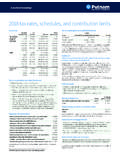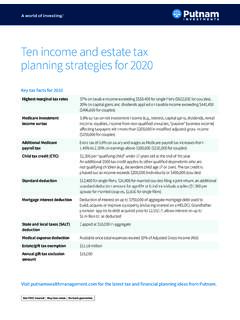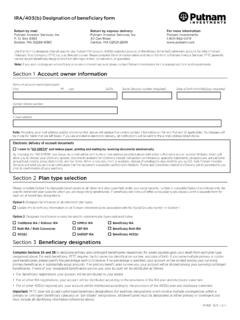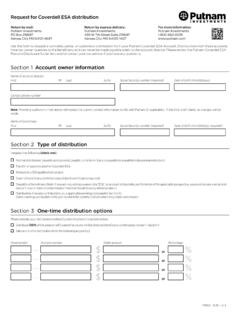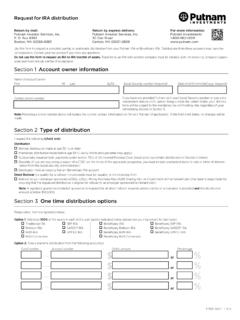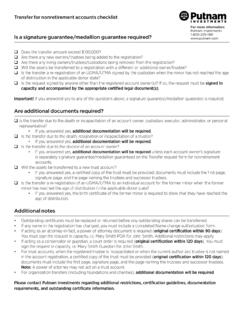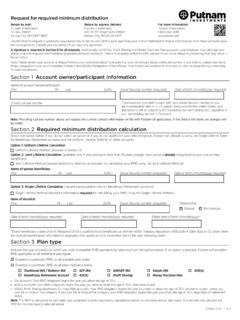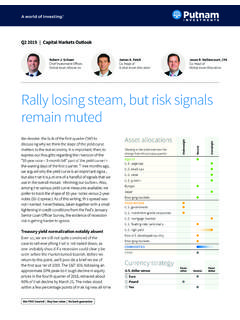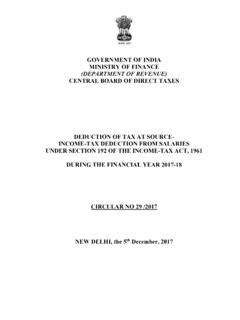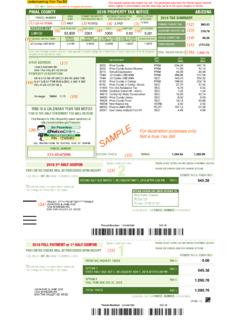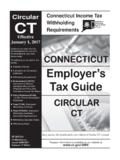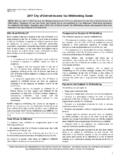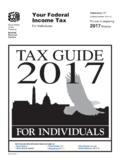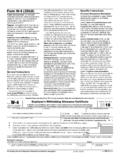Transcription of Investor Education: 2017 tax rates, schedules, and ...
1 Income taxIf taxable income is overBut not overThe tax isOf the amount overMarried/Filing jointly and qualifying widow(er)s$0$18,650$ + 10%$018,65075,9001, + 15% 18,65075,900153,10010, + 25% 75,900153,100233,35029, + 28% 153,100233,350416,70 052, + 33%233,350416,70 0470,700112, + 35% 416,70 0470,700 131, + 470,700 Single$0$9,325$ + 10%$09,32537, 9 5 + 15% 9,32537, 9 5 091,90 05, + 25%37, 9 5 091,90 0191,65018, + 28% 91,90 0191,650416,70 046, + 33% 191,650416,70 0418,40 0120, + 35% 416,70 0418,40 0 121, + ,40 0 Estates and trusts$0$2,550$ + 15%$02,5506, + 25%2,5506,0009,1501, + 28%6,0009,15012,5002, + 33%9,15012,500 3, + 12,500 Corporate taxIf taxable income is overBut not overThe tax isOf the amount over$0$50,000$0 + 15%$050,00075,0007,500 + 25%50,00075,000100,00013,750 + 34%75,000100,000335,00022,250 + 39%100,000335,00010,000,000113,900 + 34%335,00010,000,00015,000,0003,400,000 + 35%10,000,00015,000,00018,333,3335,150,0 00 + 38%15,000,00018,333.
2 333 35%0 Employer retirement plansMaximum elective deferral to retirement plans, , 401(k), 403(b)$18,000 Catch-up contribution limit for 401(k), 403(b), and 457 plans6,000 Maximum elective deferral to SIMPLE IRA plans12,500 Catch-up contribution limit for SIMPLE plans3,000 Maximum elective deferral to 457 plans of gov t and tax-exempt employers18,000 Limit on annual additions to defined contribution plans54,000 Annual compensation threshold requiring SEP contribution600 Limit on annual additions to SEP plans54,000 Maximum annual compensation taken into account for contributions270,000 Annual benefit limit under defined benefit plans215,000 Limitation used in definition of highly compensated employee120,000 Health flexible spending account maximum salary reduction contribution2,600 Sources: IRS and Social Security Administration updates tax rates , schedules, and contribution limitsTax on capital gains and qualified dividendsTax bracketShort-term capital gains ( 12 months)Long-term capital gains and qualified dividends (> 12 months)10%, 15% bracketsOrdinar y rate0%25%, 28%, 33%, 35% bracketsOrdinar y rate15% bracketOrdinar y rate20%Additional federal net investment income (NII) tax applies to individuals on the lesser of NII or modified AGI in excess of $200,000 (single) or $250,000 (married/filing jointly and qualifying widow(er)s).
3 Also applies to any trust or estate on the lesser of undistributed net income or AGI in excess of the dollar amount at which the estate/trust pays income taxes at the highest tax*$0 to $1,050 0%Earned income > $1,050 Child s tax rateUnearned income > $1,050, $2,100 Child s tax rateUnearned income > $2,100 Generally, the parent s highest marginal tax rate1 Applies if child has not attained age 18 by close of the yearIf a child s earned income represents not more than one half of support needs, the kiddie tax generally also applies to unearned income of children who have not attained age 19 by the close of the year, and children who are full-time students and have not attained age 24 as of the close of the rates on long-term capital gains and qualified dividends are appli-cable; federal NII tax is imposed separately on each childChild tax credit$1,000 per child; phases out $50 for each $1,000 of modified AGI (rounded up to the next $1,000 increment) over $110,000 (married/filing jointly) or $75,000 (single)Standard deductionsAnnualAdditional age 65+ or blindMarried/Filing jointly and qualifying widow(er)s$12,700$1,250 Single$6,350$1,550 Personal exemptions and itemized deductionsMarried/Filing jointly and qualifying widow(er)s$4,050 eachSingle$4,050 Personal exemptions and itemized deductions phase out beginning with AGI over $261,500 (single) or $313,800 (married/filing jointly and qualifying widow(er)s)Maximum compensation subject to FICA taxesOASDI (Soc.)
4 Sec.) maximum$1 27, 2 0 0HI (Medicare) maximumNo limitOASDI and HI tax rate: OASDI and HI ( combined) for self-employed; and ( combined) for employees. An additional HI tax applies on individuals with wages or self employment income in excess of $200,000 (single and qualifying widow(er)s) or $250,000 (married/filing jointly).Death/gifts occurring in 2017 * (subtract applicable credit from calculated tax)If gift/gross estate is over But not overThe tax isOf the amount over$0$10,000$0 + 18% $010,00020,0001,800 + 20%10,00020,00040,0003,800 + 22%20,00040,00060,0008,200 + 24%40,00060,00080,00013,000 + 26%60,00080,000100,00018,200 + 28%80,000100,000150,00023,800 + 30%100,000150,000250,00038,800 + 32%150,000250,000500,00070,800 + 34%250,000500,000750,000155,800 + 37%500,000750,0001,000,000248,300 + 39%750,0001,000,000 345,800 + 40%1,000,0001 Annual gift tax exclusion ( 2017 ): Individual, $14,000; Married electing split gifts, $28,000 Combined lifetime gift tax and gross estate tax exemption: $5,490,000 GST tax exemption: $5,490,000 Modified AGI phaseouts for American Opportunity Tax CreditMarried/Filing jointly$160,001 $179,999 Others$80,001 $89,999 Modified AGI phaseouts for Lifetime Learning CreditMarried/Filing jointly$112,001 $131,999 Single$56,001 $65,999 Modified AGI phaseouts for exclusion of Savings Bond Income used for higher education expensesMarried/Filing jointly$117,251 $147,249 Others$78,151 $93,149 Modified AGI phaseouts for contributions to Coverdell Education Savings Accounts Maximum contribution.
5 $2,000 per beneficiary, per yearMarried/Filing jointly$190,001 $219,999 Single$95,001 $109,9992017 AMT exemptionsSingle$54,300 Married/Filing jointly and qualifying widow(er)s$84,500 Estates and trusts$24,100 Phases out beginning with alternative minimum taxable income over $120,700 (single) or $160,900 (married/filing jointly and qualifying widow(er)s) or $80,450 (estates and trusts). AMT ordinar y income rate increases from 26% to 28% for alternative minimum taxable income over $187,800 (married/filing jointly and qualifying widow(er)s, single, and estates and trusts).Maximum Qualified Long-Term-Care insurance premiums eligible for deductionAge40 or less>40, 50>50, 60>60, 70 Over 702017$ 410$770$1,530$4,090$5,110 Qualified LTC contract per diem limit: $360 Traditional IRAsMaximum annual contribution (must be under age 701/2)Lesser of compensation or $5,500Up to $5,500 contribution can also be made for nonworking spouse Catch-up contributions (Taxpayers age 50 and over).
6 $1,000 Traditional IRA deductibility tableFiling statusCovered by employer s retirement planModified AGI 2016 Modified AGI 2017 DeductibilitySingleNoYesYesYesAny amount$61,000 or less$61,001 $70,999$71,000 or moreAny amount$62,000 or less$62,001 $71,999$72,000 or moreFullFullPartialNoneMarried/JointlyNe ither spouse coveredAny amountAny amountFullMarried/JointlyBoth spouses covered$98,000 or less $98,001 $117,999 $118,000 or more$99,000 or less$99,001 $118,999$119,000 or moreFullPartialNoneMarried/JointlyYes, but spouse is not covered$98,000 or less$98,001 $117,999$118,000 or more$99,000 or less$99,001 $118,999 $119,000 or moreFullPartialNoneMarried/JointlyNo, but spouse is covered $184,000 or less $184,001 $193,999 $194,000 or more$186,000 or less$186,001 $195,999$196,000 or moreFullPartialNoneRoth IRAsMaximum annual contribution Lesser of compensation or $5,500 Up to $5,500 contribution can also be made for nonworking spouseCatch-up contributions (Taxpayers age 50 and over): $1,000 Contribution eligibilityModified AGI is less than $118,000 (single) or $186,000 (married/filing jointly).
7 Phaseouts apply if Modified AGI is $118,000 $132,999 (single) or $186,000 $195,999 (married/filing jointly)DeductibilityContributions to Roth IRAs are not deductibleConversion eligibilityThere is no modified AGI restriction on eligibility for a Roth IRA conversionBase amount of modified AGI causing Social Security benefits to be taxableUp to 50% taxableUp to 85% taxableMarried/Filing jointly$32,001 $44,000> $44,000 Single$25,001 $34,000> $34,000 Maximum earnings before Social Security benefits are reducedUnder full retirement age ($1 withheld for every $2 above limit)$16,920 Full retirement age and overNo limit*1 Interim annual limit of $44,880 applies for months prior to attaining full retire-ment age during year individual reaches full retirement age ($1 withheld for ever y $3 above limit).This information is general in nature and is not meant as tax or legal advice. Tax laws are subject to change. Please consult your legal or tax informational purposes only.
8 Not an investment Retail ManagementPutnam Investments | One Post Office Square | Boston, MA 02109 | 307364 10/17
